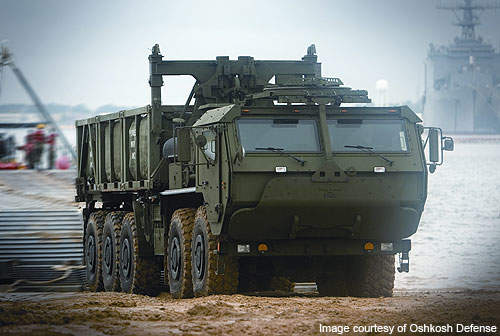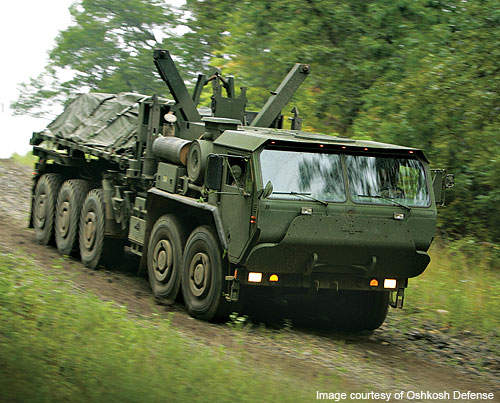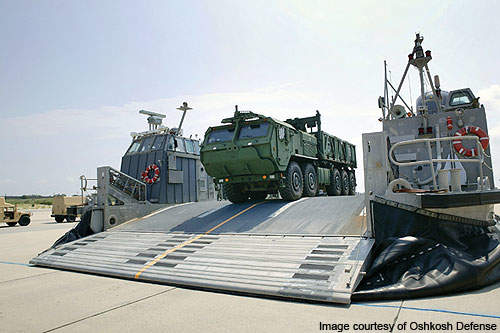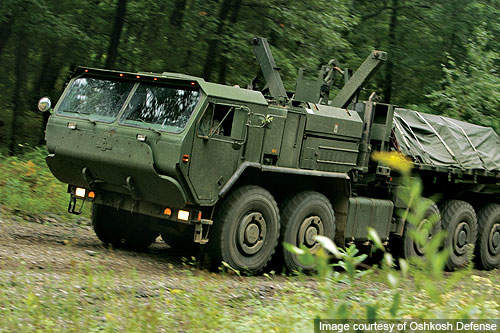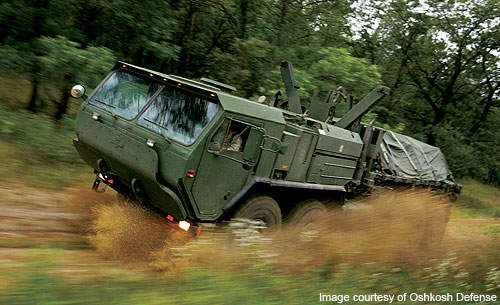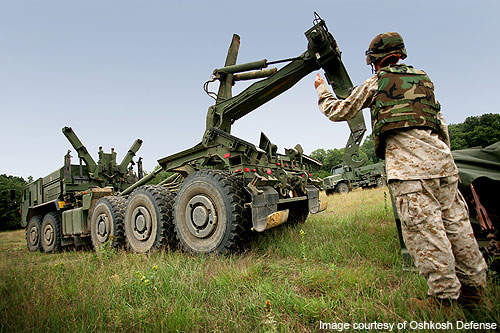The Logistics Vehicle System Replacement (LVSR) is a heavy logistics vehicle developed by Oshkosh Defense for the US Marine Corps (USMC). The ten-wheel tactical vehicle replaces the 25 year-old Logistics Vehicle System (LVS) of the marine corps. The new vehicle reduces the cargo hauling load of the USMCs MTVR fleet.
It can be used for on-road and off-road transportation of heavy loads including ammunition, bulk / break-bulk / palletized cargo, fuel, water and heavy equipment.
LVSRs are also being deployed by the Marine Air-Ground Task Force (MAGTF) in its Ground Combat Element (GCE), Aviation Combat Element (ACE) and Logistics Combat Element (LCE).
The cargo variant of LVSR was fielded in August 2009 and initial operational capability was achieved in September. Full-rate production of the cargo variant was approved in December 2009.
Logistics Vehicle System Replacement orders and deliveries
In June 2006, the USMC placed a $740.2m Low Rate Initial Production (LRIP) contract with Oshkosh Defense for 1,592 vehicles over six-years. In February 2010, Oshkosh received an additional order for an existing $158m contract from US Marine Corps Systems Command for more than 400 LVSR vehicles.
In December 2010, the company signed a $50m contract with the marine corps to supply 100 LVSR Cargo variants and 120 enhanced protection kits.
LVSR cargo, wrecker and tractor variants
LVSR is produced in three variants – cargo, wrecker and tractor.
The LVSR MKR 18 cargo vehicle is capable of transporting a payload of 22.5t on-road or 16.5t off-road. It is fitted with an integrated self loading system for cargo loading and unloading.
The LVSR MKR 15 wrecker is a high mobility vehicle. It can reach vehicles located on any terrain and can retrieve them even if they are stuck in mud, sand, water or snow. It is capable of flat towing a 49,895kg vehicle and lift towing a 43,545kg vehicle. It can recover HMMWV series, FMTV series, 5t M809 and M939 series, LVS series, MTVR series, MRAP series and LVSR series vehicles.
The LVSR MKR 16 tractor can haul semi-trailers, heavy engineering equipment and combat vehicles. It is fitted with a self-recovery winch to lift 27,216kg of equipment onto the trailer.
Heavy logistics vehicle design and features
LVSR consists of a dual axle front section integrated with one of five interchangeable rear body components.
The cabin can accommodate a two man crew, personnel protective gear and M16A2 rifles.
The vehicle is designed to operate in extreme temperatures ranging from -50°F (with Arctic Kit) to +125°F.
A range of kits including an add-on armour kit, a weapons mount, MCTAGS, a run-flat kit, an Arctic kit and a communications installation kit are provided.
Observation and control
The command zone integrated control and diagnostics system enables the crew to monitor the engine, transmission, brakes, central tire inflation system and other critical components from inside the cabin.
Self-protection
Shock absorbing seats are fitted for crew safety. The armour protection provided on the cab floor can withstand a mine blast. The factory-installed add-on armour ‘B’ kit will include armoured doors, blast-proof windshields and armour panels to enhance protection levels against improvised explosive devices and small arms fire.
Engine
LVSR is powered by a Caterpillar diesel engine coupled to an Allison 7-speed automatic transmission. The engine produces a power output of 600hp.
All LVSR variants feature single-speed transfer case, front tandem steering and driving axles, and triple driving axles of which two are steerable.
Mobility
LVSR is transportable by amphibious and commercial ships, rail and C-5A and C-17 aircraft. It is equipped with two front and two back steerable axles. This arrangement reduces the turning radius to 83ft and facilitates the vehicles easy storage aboard ship.
The TAK-4 independent suspension system allows each wheel to move up and down independently in response to uneven surfaces. It reduces strain on the axle and maintains the vehicle level on rough terrain.
The vehicle features 16R20 single radial tires and a central tire inflation system. All variants are equipped with tie down and lifting tools. A pintle hook is provided for towing the selected trailers of up to 53,000lb of gross trailer weight.

